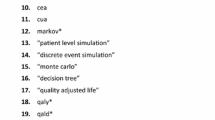Abstract
Summary
In Canada, provincial formulary review committees consider the effectiveness, safety, and cost of products when they derive advice for each Minister of Health. This article offers a draft set of guidelines for pharmaceutical manufacturers making submissions which include economic information, moving beyond a simple presentation of the unit price of the pharmaceutical product (e.g. price per day or course of therapy) and comparison to similar prices for alternative products.
A full economic analysis compares all relevant costs and clinical outcomes of the new product with alterna te therapeutic strategies for treating patients with a particular condition. The perspective of the decision maker must be clearly identified. The quality of the evidence supporting estimates of the variables incorporated in the analysis should be evaluated. Sensitivity analyses are used to assess the robustness of the qualitative conclusions.
Reviewers will examine the answers to a set of 19 questions. Manufacturers can use these questions as a worksheet for preparation of an economic analysis to be incorporated in a submission.
This article is a merger of 2 sets of economic luidelines produced by the author as a tonsultant to the Ontario lovemment and the inter-provincial workins group. It in no way renects the official polity of either the lovernments of Ontario or Canada. These guidelines are intended to be a starting point for further refinement. and discussion with health economists in industry and academia. Considerable flexibility will be used in reviewing documentation supporting economic analysis. Those preparing submissions should be encouraged to experiment with various approaches as part of the general developmcnt of this field and to engage provincial review committees in ongoing discussions.
Similar content being viewed by others
References
Birch S, Gafni A. COst-effectiventsS/utility analysis: do current decision rules lead us to where we want to be? Journal of Health Economics 11: 279–296, 1992
Coyle D, Tolky K. Discounting of hea lt benefits in the pharmacoeconomic analysis of dlUlthefapies: an issue for debate? PharmacoEconomics 2: 159–162, 1992
Department of Cinical EpidemiolocY aoo Biostatistics. McMaster Univnsity Health Scicnces Centtt. How to read dinical journals: VII. To unclnstand an economic evaluation. Part A. Canadian Medical Association Journal 130: 1428–1433, 1984a
Department of ainical EpidemiololY aoo Biostatistics. MeMasler Uni versi ty Sciences Centre. How to read d inical journals: VII. To understand an ecInomic evuation. Part B. Canadian Medical Association Journal 130: 1542–1549, 1984b
Detsky AS, Naglie IG. A clinician’s guide to cost-effectiveness analysis. Annals of Interna l Medicine 113: 147–154, 1990
Drummond MF, Stoddan GL, Torrance GW. Methods for the cconomic evalua tion of heahh care provammcs. Oxford Medical Publications, Oxford, New York, Toronto. 1987
Eisenberg J. Oinieal economiCl: a guide to the economic analysis of clinical practices. Journal of tht American Medical Association 262: 2879–2886, 1989
Freund DA, Dittus RS. Principles of pharmacoeconomic analysis of drug therapy. PharmacoEconomics 1: 20–31, 1992
Henry D. Economic analysis as a n aid to subsidillt ion decisions: The development of Australian uidclinn for pharmaceutical s. PharmacoEconomics 1: 54–67, 1992
Hillman AL, Eisenberg JM, Pauly MV, Bloom BS, Glick H, et al. Avoiding bin in the conduct and reporting of cost-effectiveness rnearch sponsored by pharmaceutical company. New England Journal of Medici ne 324: 1162–1165, 1991
Katz DA, Welch HG. Discounting in cost-effectiveness analysis of heahhcarc procntmmcs. PharmacoEconomics 1: 276–285, 1993
Krahn M, Detsky AS. Should Clnacla and the United StatCl univl y vllcdnatc infants against hepa titis B? A cost-effectiveness analysis. Medical Decision Making 13: 4–20, 1999
Krahn M, Gafni A. Discounti ng in the cconomic evaluation of health care interventions. Medical Care, in pm, 1991
Laupacis A, Feeny D, Detsky AS, Tugwell PX. Howanracti ve does a new technology have to be to warrant adoption and utilization? Tentative luidelines for usn, clinical and economic evaluations. Canadian Medical Asocialion Journal 146: 473–48, 1992
Mehrez A, Gafni A. The hulth yea rs eq ui valents: how to meas ure them usin, Ihe standard gamble approach. Medical Decision Making 11: 140–146, 1991
Mehrez A, Gafni A. Preference based outcome measure for economic evaluation of drug interventions: quality adjusled life years (QALYs) versus health years equivalents ( HYEs). PharmaooEconomics 1: 338–345, 1992
Torrance GW, Feeny D. Utilities and quality-adjusted li fe years. lnternationaJ Journal of Technology Assessment in Health Care 5: 559–579, 1989
Author information
Authors and Affiliations
Rights and permissions
About this article
Cite this article
Detsky, A.S. Guidelines for Economic Analysis of Pharmaceutical Products. Pharmacoeconomics 3, 354–361 (1993). https://doi.org/10.2165/00019053-199303050-00003
Published:
Issue Date:
DOI: https://doi.org/10.2165/00019053-199303050-00003




